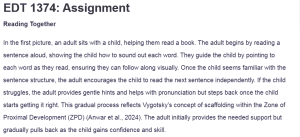EDT 1374: Assignment
Reading Together
In the first picture, an adult sits with a child, helping them read a book. The adult begins by reading a sentence aloud, showing the child how to sound out each word. They guide the child by pointing to each word as they read, ensuring they can follow along visually. Once the child seems familiar with the sentence structure, the adult encourages the child to read the next sentence independently. If the child struggles, the adult provides gentle hints and helps with pronunciation but steps back once the child starts getting it right. This gradual process reflects Vygotsky’s concept of scaffolding within the Zone of Proximal Development (ZPD) (Anwar et al., 2024). The adult initially provides the needed support but gradually pulls back as the child gains confidence and skill.

Baking Together
In the second picture, an adult and a child work together in the kitchen, making a simple recipe. The adult starts by measuring the ingredients and explaining why each measurement is important. They show the child how to hold the measuring cup steady and level it off for accuracy. After demonstrating a few steps, the adult encourages the child to measure independently. The adult watches closely, ready to assist if the child needs help, but allows the child to measure ingredients independently as they gain confidence. This hands-on experience within the child’s ZPD allows them to learn with guidance and gradually achieve mastery (Anwar et al., 2024).

In both pictures, the adult uses scaffolding by initially offering significant support and guidance, then gradually withdrawing as the child becomes more capable. This approach aligns with Vygotsky’s ZPD, which suggests that children learn best when supported beyond their current abilities (McLeod, 2024), enabling them to eventually perform tasks independently.
References
Anwar, M. N., Mushtaq, N., Mubeen, A., & Iqbal, M. (2024). The Power of ZPD: Enhancing Teaching and Learning. Journal of Education and Social Studies, 5(2), 396-405.
McLeod, S. (2024). Vygotsky’s Zone of Proximal Development. https://www.simplypsychology.org/zone-of-proximal-development.html
ORDER A PLAGIARISM-FREE PAPER HERE
We’ll write everything from scratch
Question 
Assignment Details
< 24/FA EDTC 1374-7P1TeachingMath & Science in…
Instructions
Sometimes the things students want to discover are too hard, or dangerous, or complicated. That is where we, as someone who knows more, can help. We SCAFFOLD. Vygotsky called it ZPD–Zone of proximal development. That just means we help a little, and pull back when they start “getting” it, and finally let them do it on their own.

EDT 1374: Assignment
• Submit a picture/s of an adult “scaffolding” and activity with a child.
• Look at the PPT for this module for an explanation of that word.
• Write an explanation what the adult did to scaffold in each picture. The picture does not have to look exactly like the example in the PPT, but include one that you can describe what each picture means and the steps that show “scaffolding”.
Submission type: PDF, document, or text